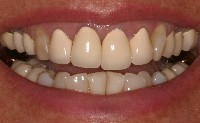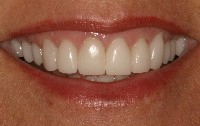Tooth bonding near my gum line looks terrible. Can it be redone?

Although the sensitivity is resolved, the problem now is that my teeth now look worse than when they had the yellow notches. The filling material color is just so off, and the filled spots look rough and opaque.
What can I do? Can I get these redone or am I stuck with this color? Could the dentist just patch a better color over them?
– Greg
Hello Greg,
We’re very sorry to hear about what you’ve gone through. Although we would normally encourage folks to see an expert cosmetic dentist to ensure they get natural-looking cosmetic dental work done, any good general dentist should be able to get the color right for the kind of restorations you had done.
So it does sound like you might want to try visiting a new dentist to get a better color match for your bonding.
On that note, let’s discuss your options for improving the look of your restorations. Keep in mind that these recommendations are based solely upon the information you have shared with us. You will need to seek a second opinion by visiting a cosmetic dentist near you in person to find out which treatment option is best for you.
Option #1: Resurfacing your fillings.
It’s possible that another dentist could simply ‘refinish’ your fillings by grinding down the surface a bit and then covering them with a composite material that matches your teeth better.
Option #2: Replacing your fillings.
There would probably be no issues with simply replacing your fillings altogether if your new dentist sees fit to do so. This shouldn’t harm your teeth at all. If the color of your current fillings makes them stand out from your teeth, then a dentist can easily see how far to drill to remove them. Even if the color was such a good match that the fillings couldn’t be easily distinguished from the teeth, a dentist would use a special drill tip that only removes composite material without harming the tooth.
An Important Note About Abfraction Lesions
Abfraction lesions are notches that develop near the gum line on teeth. These notches can become very sensitive as the enamel wears away over time, and dental bonding is a popular way to protect these sensitive notches. In previous years, dentists believed these notches were caused by aggressive tooth brushing, but now we understand that the main factor is excessive tooth clenching. Biting the teeth together causes them to flex slightly right at the point where they meet the gums. This flexing action weakens the teeth and creates that notch.
If you have a subconscious habit of clenching your teeth, then that could be the reason you developed those sensitive notches at the gum line.
Why does this matter?
The best material for restoring those notches in your teeth depends on what caused them in the first place. A stiff and inflexible material will eventually pop out when the tooth flexes. So if the lesions on your teeth were caused by clenching, then a dentist will probably select a softer and more flexible material that can move with your teeth when they flex under pressure.
This post has been published on behalf of Dr. Gilberto Tostado, a cosmetic dentist near Douglas, AZ.
Read More...Failed dental crown: Is my dentist responsible?

A few months later, I had to come in to get another tooth crowned, but I wanted my dentist to look at the painful tooth that he had crowned last time. It was still so painful that I couldn’t bite on it. He made some adjustments to my crown, but it was still sensitive no matter what we tried. The dentist kept pushing me to get that second crown, but I didn’t want to move forward with any new treatment until I got relief from the pain.
The office scheduled me for another appointment to try adjusting the crown again, but it got postponed a few times due to the pandemic. When they finally were able to see me the other day, I learned that my tooth now has a periapical abscess. I plan to get it pulled, but my dentist wants to charge me for the extraction on top of what I already paid for the failed crown.
This whole experience has been so frustrating and painful. If I knew how severe the damage was, I would have opted to pull that tooth months ago. I feel like my dentist owes me a refund for this failed crown and for the pain I’ve had to endure for months.
Is this my dentist’s fault? Why didn’t they tell me at the start that I would need a root canal or extraction? I’d like to know if I could get a refund.
— Tammy
Hello Tammy,
Based on what you’ve told us, we can understand just how frustrating your experience has been.
Your situation is a tricky one. There are signs that the dentist who placed your crown was a bit careless, but you may not have enough proof to allege malpractice or justify a refund.
Without reviewing your X-rays and dental records and hearing your dentist’s perspective, we can only guess at his rationale for crowning your cracked tooth.
Most dentists wouldn’t put a cap on a tooth that had sensitivity and showed signs of needing root canal treatment. And an ethical dentist wouldn’t ignore your pain in order to push the placement of a new crown.
It isn’t unusual for teeth to unexpectedly flare up and take a turn for the worse after being crowned. This is something that happens to even the most well-intentioned dentists, on occasion. So it’s possible that your dentist genuinely did not anticipate that your tooth would have such a severe reaction after being crowned.
It’s also possible that your dentist felt that urgent treatment was necessary to protect the second tooth from more serious damage. That could explain why it seemed your dentist was “pushing” you to get another crown, even though you weren’t yet happy with the first one.
All of this is to say that you may have a hard time proving that your dentist did anything wrong.
But this doesn’t mean that your feelings about the situation are wrong.
In fact, we can point out a few red flags worth noting:
- Your dentist, indeed, should have told you right from the start that there was a possibility you would need a root canal. The fact that he did not is concerning.
- Your dentist should not have dismissed your post-crown discomfort. A little temporary sensitivity to temperature changes is normal; pain while biting on your crown is not normal.
- When you returned months later with your first crowned tooth still causing you pain, your dentist should not have ignored that to move forward with placing a new crown. This suggests that the dentist could have been putting income ahead of patient concerns.
So in a nutshell, it appears that your dentist may have made some mistakes in judgment in your treatment, but you might have a difficult time getting compensated for that. You can try using some leverage to negotiate with your dentist for a refund on your failed crown. For example, you can complain to your state dental board or threaten to leave a negative review online. These tactics may only get you so far, however.
The best thing you can do at this point is to start looking for a new dentist.
The right dentist will take the time to answer your questions, will prioritize your comfort and concerns, and will carefully explain all of your treatment options before moving ahead with any procedure. Your new dentist can also help you weigh the pros and cons of treating a tooth with a root canal versus extracting it and replacing it with dental implants.
This post has been published on behalf of Dr. Gilberto Tostado, a dentist near Douglas, AZ.
Read More...My dentist is struggling to get the right color for my implant crown
About a year ago, I was so excited to get a dental implant to replace my missing right upper front tooth. Everything went fine with my implant procedure, but I’m disappointed in the resulting esthetics. My dentist has really struggled to get the crown color right so that it matches my left front tooth, and we’ve redone this crown at least three times now. Sometimes it’s been too dark, at other times it was noticeably too light.
I don’t know why my dentist can’t get this right. He’s getting frustrated with me, telling me I should just be grateful the implant is doing well and that it’s not his fault that my tooth color is hard to match.
He also told me that continually manipulating my implant to change the crown could compromise the implant itself.
I don’t mean to be so difficult; it’s just that I want my new implant to look like a natural tooth since it’s so visible. But I also don’t want to risk damaging my implant.
What should I do at this point?
Thanks for any advice you can share,
Paul from Phoenix, AZ
Getting matching dental crowns makes a world of difference!


Dear Paul,
Getting a dental implant is an exciting step that can change your life for the better, so we’re glad to hear your procedure was successful. But we’re sad to hear that you’ve had such a frustrating experience with your current dentist.
The good news is that your situation is not as hopeless as it may seem. You can safely get a new crown for your implant that matches the neighboring teeth!
There are three things we want to make sure you’re aware of.
Point number one: it may help you to hear that you are not being unreasonable. Given that the tooth in question (maxillary central incisor) is one of your most prominent teeth, it’s only natural to want your implant restoration to blend in seamlessly with the rest of your smile, so there’s no need to worry that you’re being a “difficult” patient.
Point number two: it is perfectly safe to grind off your current crown in order to replace it with a new one. Get a second opinion from a dental implant dentist who has extensive experience in esthetic implant restoration.
This brings us to:
Point number three: your current dentist doesn’t seem to be a very experienced cosmetic dentist, and this could be the reason he’s not interested in creating a closer match for your implant crown.
It’s not an easy feat to get a perfect match. Even skilled cosmetic dentists need to try in a crown more than once to make sure the color match is true before they bond the crown in place.
Many general dentists rely on an industry-standard shade guide to pick colors for their crowns. This guide, however, doesn’t account for all the subtle variations in color that can occur naturally in human teeth. Dentists who rely heavily on this guide and have little to no interest in achieving an exact match don’t put in the time to customize the hue or to communicate specific color instructions to their dental lab ceramist.
So in short, it sounds like your current dentist may not be putting in the effort necessary to create a well-matched restoration for your implant. You need to work with a dentist who takes an artistic approach to restoring dental implants and is willing to try in your dental crown and make needed adjustments multiple times before permanently cementing it onto your implant.
Posted on behalf of Dr. Tostado, a cosmetic dentist near Douglas AZ.
Read More...
How to Get a Refund from a Dental Chain for Faulty Dental Work
I’ve been visiting a large dental chain in Tucson for my dental checkups and treatment since 2015. I normally visit the chain’s location that is near my place of work, and I had multiple dental fillings placed there last year.
But I recently booked a checkup at a different location that’s closer to where I live, and at that location, the dentist told me I needed to crown a tooth that was filled only four months ago. When I told the dentist that tooth was recently filled at the other practice location, he got really quiet, and that’s when I started to get a little suspicious.
I decided to get a second opinion from a dentist who isn’t part of that dental chain. After she reviewed my X-rays and looked at my teeth, she confirmed that I did need a crown, but she also said that I would need to have almost all of the other fillings redone as well.
I almost don’t know who to believe, anymore. This new dentist does seem trustworthy, but I want to be compensated for all of that poorly done dental work before I go ahead and agree to her treatment plan.
How can I get a refund from the large dental chain that did such a terrible job on my fillings?
Colin from Tucson, AZ
Dear Colin,
We’re really sorry to hear that you’ve had an experience that shook your trust in dental professionals. It is possible that you have been a victim of dental malpractice, but we should warn you that it can be difficult to wrestle a refund out of these corporate dental chains.
Even so, we hope that the advice we can offer in this situation will help you make a confident and informed decision about your treatment.
Step #1: Get A Third Opinion
Here’s the very first thing you should do: seek a third opinion and make sure it’s a blind one.
This is important because what you need most right now is an unbiased assessment of your dental treatment needs. We can’t provide you with that here over the Internet, but we do suggest that you schedule a dental exam and X-rays with an independent dentist who knows nothing of your dental treatment history. In other words, don’t tell this new dentist about the treatment recommended by the other dentists.
This way, you will have one more professional opinion to weigh against the two you already have and this can give you leverage in your case. Additionally, you can be sure that the new treatment recommendations are based on what this new dentist sees in your mouth and on your X-rays, and that the recommendations are not influenced by their knowledge of your treatment history.
Remember to do the following before choosing a new dentist for your third opinion:
- Request a copy of your dental X-rays and records from the other dentists you’ve seen
- Choose a dentist who has no connections to the others you’ve visited
- Do research to ensure that this new dentist has a solid reputation
After seeing this new dentist, make sure you leave with copies of your X-rays and records from that appointment.
Step #2: Enlist the Help of Your Current Dentist
It sounds like you may wish to let your current dentist provide your treatment. If you want to stay with her practice, tell her so and ask for her help in attempting to get a refund from the large dental chain. Let her know that you will be getting a blind third opinion.
Once you have that third (unbiased!) opinion, share the findings with your current dentist. She can then get in touch with the first dental practice which provided you with that faulty dental work and let them know that you have received professional evaluations from two independent dentists and use this as the basis for negotiating your refund.
Step #3: Confront the Dental Practice You Suspect Is at Fault
What if the original practice that provided you with the failed treatment refuses to refund you? Try to engage the practice in negotiations by doing the following.
- Threaten to leave a negative review. Let the practice know that you will be sharing a review of your negative experience online.
- Tell them you will file a formal complaint with your state dental board.
- Inform your dental insurance provider of the incident. If you had a dental benefits plan you used while visiting that original dentist, let them know what happened and ask if they can help support your case.
- Attempt to open a malpractice lawsuit against the practice. This is the final and most drastic option left to you, but it may not be worth pursuing unless you can furnish enough proof of significant financial loss and/or suffering. Simply mentioning that you will contact an attorney may be enough to motivate the dental chain to compensate you.
The Challenge of Visiting Dental Chains
Once again, we’re sorry to learn about your negative experience, Colin. It may comfort you to know that independent dentists are a very ethical group, on the whole.
Dentists who work in the corporate setting are also dedicated professionals, but they tend to see such a high volume of patients that it is hard for them to render the personal level of care that each patient deserves. Many of these dentists are under pressure to meet production goals that support the growth of the chain, and some may even be new dentists who have accepted a corporate position to gain some experience.
Such factors can sometimes result in an unfortunate lapse in the high standard of care that most dentists truly want to provide.

By choosing an independent dentist with a stellar reputation and extensive experience, you will work one-on-one with a professional you can trust and develop a long-term relationship with. You will then be able to move ahead with full confidence in the recommended treatment plan.
Having a dentist you can trust becomes all the more important when you are considering major treatment like dental implants or porcelain veneers.
This post is sponsored by Douglas AZ Dentist Dr. Gilberto Tostado.
Read More...

 Infinity Business Web
Infinity Business Web